- State Board
-
12th Standard
-

Biology
-

Computer Applications
-

Computer Science
-

Business Maths and Statistics
-

Commerce
-

Economics
-

Maths
-

Chemistry
-

Physics
-

Computer Technology
-

History
-

Accountancy
-

Tamil
-

Maths
-

Chemistry
-

Physics
-

Biology
-

Computer Science
-

Business Maths and Statistics
-

Economics
-

Commerce
-

Accountancy
-

History
-

Computer Applications
-

Computer Technology
-

English
12th Standard stateboard question papers & Study material
தமிழ் Subjects
English Subjects
-
-
11th Standard
-

Maths
-

Biology
-

உயிரியல் - தாவரவியல்
-

Economics
-

Physics
-

Chemistry
-

History
-

Business Maths and Statistics
-

Computer Science
-

Accountancy
-

Commerce
-

Computer Applications
-

Computer Technology
-

Tamil
-

Maths
-

Commerce
-

Economics
-

Biology
-

Business Maths and Statistics
-

Accountancy
-

Computer Science
-

Physics
-

Chemistry
-

Computer Applications
-

History
-

Computer Technology
-

Tamil
-

English
11th Standard stateboard question papers & Study material
தமிழ் Subjects
English Subjects
-
-
9th Standard
-

-

-

-

-

-

-

Maths
-

Science
-

Social Science
-

Maths
-

Science
-

Social Science
9th Standard stateboard question papers & Study material
தமிழ் Subjects
English Subjects
-
-
6th Standard
-

Maths
-

Science
-

Social Science
-

Maths
-

Science
-

Social Science
6th Standard stateboard question papers & Study material
தமிழ் Subjects
English Subjects
-
-
10th Standard
-

Maths
-

Science
-

Social Science
-

Tamil
-

Maths
-

Science
-

Social Science
-

English
-

English
10th Standard stateboard question papers & Study material
தமிழ் Subjects
English Subjects
-
-
7th Standard
-

Maths
-

Science
-

Maths
-

Science
-

Social Science
7th Standard stateboard question papers & Study material
தமிழ் Subjects
English Subjects
-
-
8th Standard
-

கணிதம் - old
-

Science
-

Social Science
-

கணிதம்
-

Maths
-

Science
-

Social Science
8th Standard stateboard question papers & Study material
தமிழ் Subjects
English Subjects
-
-
12th Standard
- CBSE Board
-
12th Standard CBSE
-

Biology
-

Chemistry
-

Physics
-

Maths
-

Accountancy
-

Business Studies
-

Economics
-

Introductory Micro and Macroeconomics
-

Computer Science
-

Geography
-

English
-

History
-

Indian Society
-

Physical Education
-

Sociology
-

Political Science
-

Engineering Graphics
-

Bio Technology
-

Entrepreneurship
-

Hindi Elective
-

Home Science
-

Legal Studies
-

Psychology
-

Hindi Core
-

Tamil
12th Standard CBSE Subject Question Paper & Study Material
-
-
11th Standard CBSE
-

Physics
-

Mathematics
-

Chemistry
-

Biology
-

Economics
-

Business Studies
-

Accountancy
-

Computer Science
-

English
-

Geography
-

History
-

Physical Education
-

Psychology
-

Sociology
-

Bio Technology
-

Enterprenership
-

Hindi
-

Home Science
-

Political Science
-

Applied Mathematics
11th Standard CBSE Subject Question Paper & Study Material
-
- 10th Standard CBSE
-
9th Standard CBSE
-

Social Science
-

Mathematics
-

Science
-

English
-

Hindi
9th Standard CBSE Subject Question Paper & Study Material
-
-
8th Standard CBSE
-

Social Science
-

Science
-

Mathematics
-

English
8th Standard CBSE Subject Question Paper & Study Material
-
-
7th Standard CBSE
-

Social Science
-

Science
-

Mathematics
-

English
7th Standard CBSE Subject Question Paper & Study Material
-
-
6th Standard CBSE
-

Social Science
-

Science
-

Mathematics
-

English
6th Standard CBSE Subject Question Paper & Study Material
-
-
12th Standard CBSE
- Free Online Test
- News
- Study Materials
-
Students
-

Stateboard Tamil Nadu
-

CBSE Board
-

Free Online Tests
-

Educational News
-

Scholarships
-

Entrance Exams India
-

Video Materials
Study Materials , News and Scholarships
-
-
Students

12th Standard Physics English Medium Model 5 Mark Book Back Questions (New Syllabus 2020) Question Bank Software Sep-29 , 2020
12th Standard Physics English Medium Model 5 Mark Book Back Questions (New Syllabus 2020)
Model 5 Mark Book Back Questions (New Syllabus 2020)
12th Standard
-
Reg.No. :
Physics
Time :
01:00:00 Hrs
Total Marks :
115
-
Calculate the electric flux through the rectangle of sides 5 cm and 10 cm kept in the region of a uniform electric field 100 NC-1. The angle θ is 60°. If θ becomes zero, what is the electric flux?
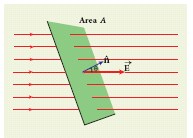
-
Find the equivalent capacitance between P and Q for the configuration shown below in the figure (a).
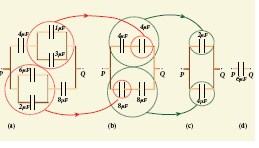
-
Consider an electron travelling with a speed vo and entering into a uniform electric field \(\vec{E}\) which is perpendicular to \(\vec { { v }_{ 0 } } \) as shown in the Figure. Ignoring gravity, obtain the electron’s acceleration, velocity and position as functions of time.
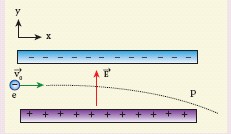
-
A point charge of +10 μC is placed at a distance of 20 cm from another identical point charge of +10 μC. A point charge of -2 μC is moved from point a to b as shown in the figure. Calculate the change in potential energy of the system? Interpret your result.
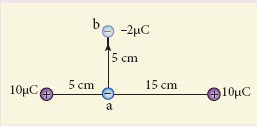
-
From the given circuit,
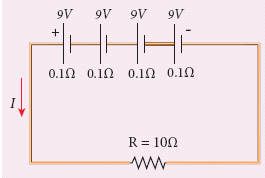
Find
i) Equivalent emf of the combination
ii) Equivalent internal resistance
iii) Total current
iv) Potential difference across external resistance
v) Potential difference across each cell -
What is the value of x when the Wheatstone’s network is balanced?
P = 500 Ω, Q = 800 Ω, R = x + 400, S = 1000 Ω
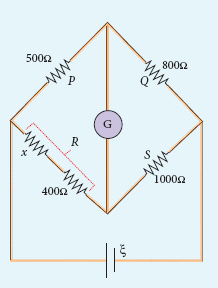
-
The current through an element is shown in the figure. Determine the total charge that pass through the element at a) t = 0 s, b) t = 2 s, c) t = 5s
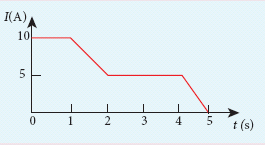
-
What is the magnetic field at the centre of the loop shown in figure?
-
Compute the work done and power delivered by the Lorentz force on the particle of charge q moving with velocity \(\vec { v } \). Calculate the angle between Lorentz force and velocity of the charged particle and also interpret the result.
-
Suppose a cyclotron is operated to accelerate protons with a magnetic field of strength 1 T. Calculate the frequency in which the electric field between two Dees could be reversed.
-
A bar magnet having a magnetic moment \({ \vec { { p } } }_{ m }\) is cut into four pieces i.e., first cut into two pieces along the axis of the magnet and each piece is further cut along the axis into two pieces. Compute the magnetic moment of each piece.
-
Show that the magnetic field at any point on the axis of the solenoid having n turns per unit length is \(B=\frac { 1 }{ 2 } { \mu }_{ ° }nI(cos{ \theta }_{ 1 }-cos{ \theta }_{ 2 })\).
-
Find the instantaneous value of alternating voltage v = 10sin (3π x 104 t) volt at
i) 0 s
ii) 50 μs
iii) 75 μs. -
A step-down transformer connected to main supply of 220 V is used to operate 11V, 88W lamp. Calculate
(i) Voltage transformation ratio and
(ii) Current in the primary. -
When does power factor of a series RLC circuit become maximum?
-
Let an electromagnetic wave propagate along the x-direction, the magnetic field oscillates at a frequency of 1010 Hz and has an amplitude of 10−5 T, acting along the y-direction. Then, compute the wavelength of the wave. Also write down the expression for electric field in this case.
-
A beam of light of wavelength 600 nm from a distant source falls on a single slit 1 mm wide and the resulting diffraction pattern is observed on a screen 2 m away. What is the distance between the first dark fringes on either side of the central bright fringe?
-
Lights of two wavelengths 560 nm and 420 nm are used in Young’s double slit experiment. Find the least distance from the central fringe where the bright fringes of the two wavelengths coincide. Given D = 1 m and d = 3 mm.
-
A man with a near point of 25 cm reads a book which has small print using a magnifying lens of focal length 5 cm.
(a) What are the closest and the farthest distances at which he should keep the lens from the book?
(b) What are the maximum and the minimum magnification possible? -
When a 6000Å light falls on the cathode of a photo cell, photoemission takes place. If a potential of 0.8 V is required to stop emission of electron, then determine the
(i) frequency of the light
(ii) energy of the incident photon
(iii) work function of the cathode material
(iv) threshold frequency and
(v) net energy of the electron after it leaves the surface. -
Find the de Broglie wavelength associated with an alpha particle which is accelerated through a potential difference of 400 V. Given that the mass of the proton is 1.67 x 10–27 kg.
-
Calculate the mass defect and the binding energy per nucleon of the \(_{ 47 }^{ 108 }{ Ag }\) nucleus. [atomic mass of Ag = 107.905949]
-
In the circuit shown in the figure, the BJT has a current gain (β) of 50. For an emitter-base voltage VEB = 600 mV, calculate the emitter-collector voltage VEC (in volts).
Part A
23 x 5 = 115






 12th Standard Physics Syllabus
12th Standard Physics Syllabus  12th Standard Physics Study Materials
12th Standard Physics Study Materials 12th Standard Physics MCQ Practise Tests
12th Standard Physics MCQ Practise Tests 

Reviews & Comments about 12th Standard Physics English Medium Model 5 Mark Book Back Questions (New Syllabus 2020)
Write your Comment